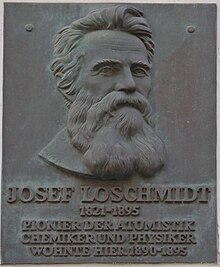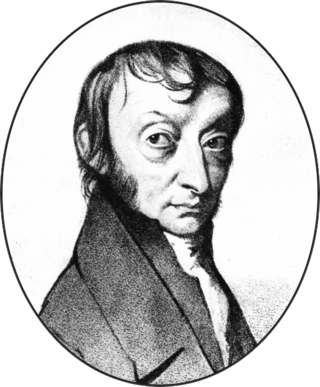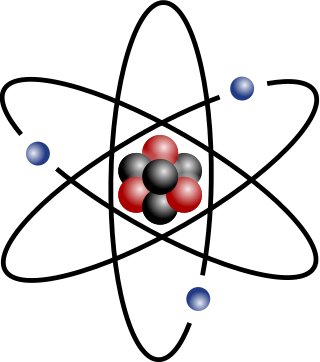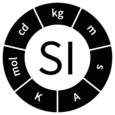History
Origin of the concept

The interpretation of the law of definite proportions in terms of the atomic theory of matter implied that the masses of atoms of various elements had definite ratios that depended on the elements. While the actual masses were unknown, the relative masses could be deduced from that law. In 1803 John Dalton proposed to use the (still unknown) atomic mass of the lightest atom, hydrogen, as the natural unit of atomic mass. This was the basis of the atomic weight scale. [12]
For technical reasons, in 1898, chemist Wilhelm Ostwald and others proposed to redefine the unit of atomic mass as 1/16 the mass of an oxygen atom. [13] That proposal was formally adopted by the International Committee on Atomic Weights (ICAW) in 1903. That was approximately the mass of one hydrogen atom, but oxygen was more amenable to experimental determination. This suggestion was made before the discovery of isotopes in 1912. [12] Physicist Jean Perrin had adopted the same definition in 1909 during his experiments to determine the atomic masses and the Avogadro constant. [14] This definition remained unchanged until 1961. [15] [16] Perrin also defined the "mole" as an amount of a compound that contained as many molecules as 32 grams of oxygen (O
2). He called that number the Avogadro number in honor of physicist Amedeo Avogadro.
Isotopic variation
The discovery of isotopes of oxygen in 1929 required a more precise definition of the unit. Two distinct definitions came into use. Chemists choose to define the AMU as 1/16 of the average mass of an oxygen atom as found in nature; that is, the average of the masses of the known isotopes, weighted by their natural abundance. Physicists, on the other hand, defined it as 1/16 of the mass of an atom of the isotope oxygen-16 (16O). [13]
Definition by IUPAC
The existence of two distinct units with the same name was confusing, and the difference (about 1.000282 in relative terms) was large enough to affect high-precision measurements. Moreover, it was discovered that the isotopes of oxygen had different natural abundances in water and in air. For these and other reasons, in 1961 the International Union of Pure and Applied Chemistry (IUPAC), which had absorbed the ICAW, adopted a new definition of the atomic mass unit for use in both physics and chemistry; namely, 1/12 of the mass of a carbon-12 atom. This new value was intermediate between the two earlier definitions, but closer to the one used by chemists (who would be affected the most by the change). [12] [13]
The new unit was named the "unified atomic mass unit" and given a new symbol "u", to replace the old "amu" that had been used for the oxygen-based units. [17] However, the old symbol "amu" has sometimes been used, after 1961, to refer to the new unit, particularly in lay and preparatory contexts.
With this new definition, the standard atomic weight of carbon is about 12.011 Da, and that of oxygen is about 15.999 Da. These values, generally used in chemistry, are based on averages of many samples from Earth's crust, its atmosphere, and organic materials.
Adoption by BIPM
The IUPAC 1961 definition of the unified atomic mass unit, with that name and symbol "u", was adopted by the International Bureau for Weights and Measures (BIPM) in 1971 as a non-SI unit accepted for use with the SI. [18]
Unit name
In 1993, the IUPAC proposed the shorter name "dalton" (with symbol "Da") for the unified atomic mass unit. [19] [20] As with other unit names such as watt and newton, "dalton" is not capitalized in English, but its symbol, "Da", is capitalized. The name was endorsed by the International Union of Pure and Applied Physics (IUPAP) in 2005. [21]
In 2003 the name was recommended to the BIPM by the Consultative Committee for Units, part of the CIPM, as it "is shorter and works better with [SI] prefixes". [22] In 2006, the BIPM included the dalton in its 8th edition of the SI brochure of formal definitions as a non-SI unit accepted for use with the SI. [23] The name was also listed as an alternative to "unified atomic mass unit" by the International Organization for Standardization in 2009. [24] [25] It is now recommended by several scientific publishers, [26] and some of them consider "atomic mass unit" and "amu" deprecated. [27] In 2019, the BIPM retained the dalton in its 9th edition of the SI brochure, while dropping the unified atomic mass unit from its table of non-SI units accepted for use with the SI, but secondarily notes that the dalton (Da) and the unified atomic mass unit (u) are alternative names (and symbols) for the same unit. [1]
2019 redefinition of the SI base units
The definition of the dalton was not affected by the 2019 redefinition of SI base units, [28] [29] [1] that is, 1 Da in the SI is still 1/12 of the mass of a carbon-12 atom, a quantity that must be determined experimentally in terms of SI units. However, the definition of a mole was changed to be the amount of substance consisting of exactly 6.02214076×1023 entities and the definition of the kilogram was changed as well. As a consequence, the molar mass constant remains close to but no longer exactly 1 g/mol, meaning that the mass in grams of one mole of any substance remains nearly but no longer exactly numerically equal to its average molecular mass in daltons, [30] although the relative standard uncertainty of 4.5×10−10 at the time of the redefinition is insignificant for all practical purposes. [1]














